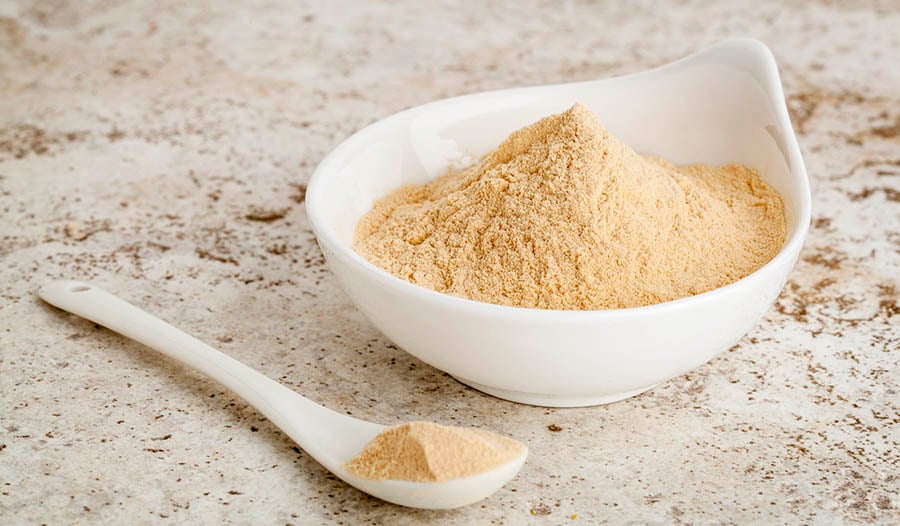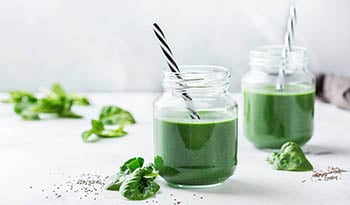Top 5 Maca Health Benefits: Boost Energy, Enhance Stamina, Improve Fertility, and More
DISCLAIMER:This blog does not intend to provide diagnosis...
- In this article:
- Where Does Maca Come From?
- What Is Maca?
- Maca's Nutritional Content
- Maca Supplements
- Health Benefits of Maca
- Maca Dosage and Considerations

Originally posted February 2018 / Updated August 2023
One of the amazing natural phenomena is a plant's ability to adapt to its environment. The composition of active compounds in a plant can be significantly influenced by geography, altitude, climate, and other factors. These stressors will often lead to the formation of protective factors within the plant to help it survive. Often, these compounds also exert significant effects in improving human health.
A great example of this environmental influence leading to different expressions of chemical composition within a plant is Peruvian Maca (Lepidium meyenii).
This fascinating member of the cabbage family is a close relative of the turnip, but lumping it in with common cruciferous vegetables is almost a disservice to its health benefits, even with other members of the cabbage family having their own list of health-improving benefits.
Maca is remarkable and is worthy of the reverence associated with it.
Where Does Maca Come From?
Maca is native to the northern Puna region of Peru and Bolivia, where the elevation is typically 11,000 to 14,000 feet, just above the tree line but below the permanent snow cap. Maca is the highest-elevation food crop in the world. However, the Puna area is challenging for crops beyond its elevation. At any time of the year, temperatures can range from below-freezing to 60° F. Even when the area experiences drought in terms of precipitation, humidity remains relatively high.
As a result, frosts are frequent, including during the growing season. Here is the bottom line point, all of these environmental stressors result in the unique chemical composition of Peruvian Maca.
What Is Maca?
Maca is a small plant that grows about six inches tall and across. Its turnip-shaped root ranges roughly 1 inch to 3 inches in diameter at harvest. This root has been treasured for thousands of years for its ability to increase energy, stamina, and fertility. For the people of the Puna, it is still a valuable food.
Maca has a strong, bitter taste. But it also has a sweetness to it as well. It is an exciting and unusual flavor, and there is a variance in the taste due to changes in growing conditions. Different forms of Maca also vary in their chemical composition and applications. The roots grow in 3 primary color groups:
- Yellow Maca is about 60% of all Maca roots harvested in Peru. It is the most commonly used and the most researched of all Maca products. It works to boost energy, enhance concentration, and balance hormones.
- Red Maca comprises about 25% of the annual harvest and is the sweetest tasting of all Maca powders. Studies have shown it to have the highest phytochemical levels of all Maca colors. It is regarded as the most effective type for women due to its hormone-balancing effects and action on bone health.
- Black Maca is the rarest of all Maca colors, making up around 15% of the annual harvest. Studies have shown black Maca to be the most effective for men, especially for muscle building, endurance, mental focus, and libido.
Maca's Nutritional Content
Dried powdered Maca is nutrient-dense, especially in minerals like calcium, magnesium, zinc, and potassium. It also contains approximately 13-16% protein and is rich in essential amino acids. It is also rich in fiber (8.5%), carbohydrates (59%), and free fatty acids (2.2%). Despite its excellent nutritional profile, even more, exciting are the phytochemicals of Maca. There are many unique compounds, but first, it is important to point out that members of the cruciferous vegetable family are all known to contain compounds known as glucosinolates. These compounds are valuable health-promoting agents in kale, cabbage, broccoli, etc., that also positively influence hormonal metabolism. The glucosinolates in Maca are unique, with the benzyl glucosinolates and glucotropaeolin being especially important to its action.
Maca also contains some unique alkaloids collectively called macamides, including macaridine and macaene. Alkaloids are generally fast-acting compounds. These maca alkaloids exert their action on central control mechanisms in the hypothalamus, pituitary, adrenals, and other endocrine organs. Much of the adaptogenic effect of Maca is likely due to these valuable compounds.
Anthocyanidins and other flavonoids best known from berries are responsible for the pigmentation of black and red Maca. These pigments also contribute to some of the health benefits, especially antioxidant activity.
Maca also contains alkamides. These compounds are best known as the tongue-tingling components of Echinacea.
Lastly, Maca contains a number of sterols, including brassicasterol, beta-sitosterol, campesterol, and stigmasterol.
When I look at the chemical composition of Maca, I can understand why it is such a unique-tasting food. Still, I also can see how subtle variations in the ratios of these active components in the different Maca color types and the gelatinized extract could yield other effects.
Maca Supplements
Peruvian maca powder is prepared from roots that are harvested, sun-dried, cleaned, and ground into a fine powder. During this process, the roots are never heated above 45 C (115 F), thereby preserving the maximum amount of nutrients, enzymes, and beneficial glucosinolates.
In preparing gelatinized maca powder, the sun-dried roots are first boiled and then pressurized to remove all starch content. It takes 4 kg of maca powder to produce 1 kg of gelatinized maca extract (a 4:1 ratio). Heating the Maca destroys the enzymes and alters some of the glucosinolates, but it does concentrate many of the active compounds as well as make them easier to digest. For example, heating increases the formation of sulforaphane, a derivative of Maca glucosinolates and best known as a component in broccoli sprouts.
Health Benefits of Maca
Since Maca is consumed in naturally dried forms by Peruvians native to the central Andes, there is a historical study population to look to for the safety and effects of Maca. One study, in particular, is worth mentioning.
One study assessed maca consumption, sociodemographic aspects, health status, and fractures in men and women aged 35–75 years old in this population. The results indicated that Maca consumption was associated with significantly higher scores in health status. It was also associated with a lower rate of fractures and lower scores of signs and symptoms of chronic mountain sickness. In addition, maca consumption was associated with lower body mass index and blood pressure.
Another study showed similar results on health scores but showed Maca consumption was associated with lower levels of interleukin-6 (IL-6), an essential marker for inflammation and oxidative damage. High serum IL-6 levels have been associated with aging, obesity, increased incidence of cardiovascular disease, cognitive impairment, and a shorter life expectancy. Higher IL-6 levels are also associated with living at higher altitudes. Hence, nature provided an answer to those living in the high altitudes of the Andes.
1. Maca Is an Adaptogen
Maca bears all of the criteria to meet being classified as an "adaptogen." That is probably why it is mistakenly referred to as Peruvian ginseng by some marketers. Maca is not in the ginseng family but does possess ginseng-like adaptogenic activity. Adaptogens have historically been used to:
- Restore vitality in debilitated and feeble individuals
- Increase feelings of energy
- Improve mental and physical performance
- Prevent the negative effects of stress and enhance the body's response to stress
One of the consistent findings in the human clinical data is that Maca boosts mood scores, reduces the feeling of stress and anxiety, and increases perceived energy levels.
2. Maca and Sexual Function
One of Maca's most renowned benefits is enhancing sexual desire and function for both men and women. Clinical trials confirm these properties, including Maca's benefits in erectile function. In men, Maca does not appear to affect the testosterone level directly. Still, it acts on the entire endocrine system to reduce the harmful effects of stress while improving mood, energy, and endurance.
Women also respond well to Maca. For example, in one small randomized, double-blind, placebo-controlled crossover trial in postmenopausal women, Maca was shown to reduce anxiety and depression and lower measures of sexual dysfunction.
The reality is that sexual dysfunction is highly prevalent in modern society worldwide, affecting 20–30% of men and 40–45% of women. Most sexual dysfunction is related to reduced sexual desire in females and males and erectile dysfunction (ED) in men. Since Maca impacts and improves both significant causes of sexual dysfunction, it is little wonder that this application has probably become why most men and women want to add Maca to their diet.
3. Maca and Semen Quality
Maca has long been used to promote improved fertility. Some studies in men dealing with poor sperm function and semen quality support this historical use. In a double-blind trial, sixty-nine men diagnosed with mild decreased sperm mobility (asthenozoospermia) and low sperm counts were given Maca (2 g per day) or placebo for 12 weeks. The men treated with Maca showed a significant improvement in seminal concentration, but there were no significant differences in semen volume, sperm mobility, and morphology when compared to both groups. These results indicate that Maca has mild benefits in this application.
4. Maca and Menopausal Symptoms
Maca has been used in Peru to help menopausal women. In a four-month study, postmenopausal women taking 2 g of maca powder per day showed a balancing effect on levels of hormones (FSH, estrogen, progesterone, and ACTH) and a reduction in the frequency of hot flushes, night sweating, interrupted sleep patterns, nervousness, depression, and heart palpitations. There was also a reduction in body weight, blood pressure and increased serum HDL cholesterol and iron. These results support the historical use of Maca in postmenopausal women.
5. Maca and Blood Pressure
One of the findings in the study mentioned above in Peruvian Andeans was a blood pressure lowering effect with Maca. And in a double-blind study in healthy men, gelatinized Maca reduced systolic and diastolic blood pressure after 12 weeks of use. Another study on postmenopausal women showed a blood pressure-lowering effect with regular Maca powder.
Maca Dosage and Considerations
The standard dose for dried powdered Maca or gelatinized Maca is typically 1,500-3,000 mg once or twice daily. Higher dosages may be required for more therapeutic effects, but a daily dosage of 1.5-6 g is appropriate for a general health boost.
Remember that there are individualized responses to Maca, just like any food.
Maca is generally very well-tolerated. If it does cause some gastrointestinal irritation, consider the gelatinized form and always discuss it with your healthcare provider before making changes to your regimen.
References:
- Da Silva Leitão Peres N , Cabrera Parra Bortoluzzi L , Medeiros Marques LL , et al. Medicinal effects of Peruvian Maca (Lepidium meyenii): a review. Food Funct. 2020;11(1):83-92.
- Chen R, Wei J, Gao Y. A review of the study of active components and their pharmacology value in Lepidium meyenii (Maca). Phytother Res. 2021;10.1002
- Gonzales GF, Gasco M, Lozada-Requena I. Role of Maca (Lepidium meyenii) consumption on serum interleukin-6 levels and health status in populations living in the Peruvian Central Andes over 4000 m of altitude. Plant Foods Hum Nutr. 2013;68(4):347-351.
- Zenico T, Cicero AF, Valmorri L, Mercuriali M, Bercovich E. Subjective effects of Lepidium meyenii (Maca) extract on well-being and sexual performances in patients with mild erectile dysfunction: a randomised, double-blind clinical trial. Andrologia. 2009 Apr;41(2):95-9.
- Beharry S, Heinrich M. Is the hype around the reproductive health claims of Maca (Lepidium meyenii Walp.) justified? J Ethnopharmacol. 2018 Jan 30;211:126-170.
- Gonzales GF, Córdova A, Vega K, et al. Effect of Lepidium meyenii (Maca), a root with aphrodisiac and fertility-enhancing properties, on serum reproductive hormone levels in adult healthy men. J Endocrinol. 2003 Jan;176(1):163-8.
- Gonzales GF, Córdova A, Vega K, et al. Effect of Lepidium meyenii (MACA) on sexual desire and its absent relationship with serum testosterone levels in adult healthy men. Andrologia. 2002 Dec;34(6):367-72.
- Brooks NA, Wilcox G, Walker KZ, et al. Beneficial effects of Lepidium meyenii (Maca) on psychological symptoms and measures of sexual dysfunction in postmenopausal women are not related to estrogen or androgen content. Menopause. 2008 Nov-Dec;15(6):1157-62.
- Alcalde AM, Rabasa J. Does Lepidium meyenii (Maca) improve seminal quality?. Andrologia. 2020;52(10):e13755.
- Meissner HO, Reich-Bilinska H, Mscisz A, Kedzia B. Therapeutic Effects of Pre-Gelatinized Maca (Lepidium Peruvianum Chacon) used as a Non-Hormonal Alternative to HRT in Perimenopausal Women - Clinical Pilot Study. Int J Biomed Sci. 2006;2(2):143-159.
- Stojanovska L, Law C, Lai B, et al. Maca reduces blood pressure and depression, in a pilot study in postmenopausal women. Climacteric. 2015;18(1):69-78.

 By Dr. Michael Murray, N.D.
By Dr. Michael Murray, N.D. 


